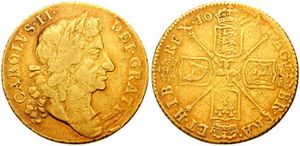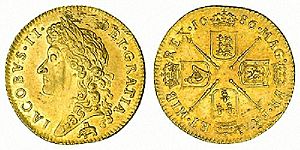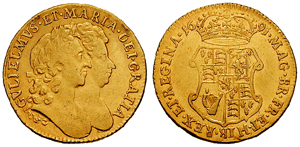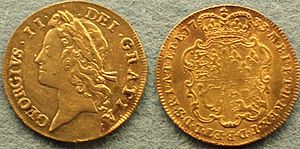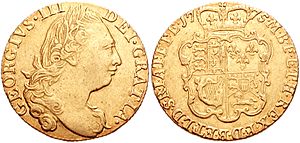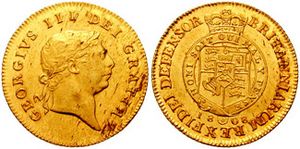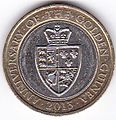Guinea (coin) facts for kids
The guinea (pronounced GIN-ee) was a special gold coin made in Great Britain between 1663 and 1814. It weighed about a quarter of an ounce of gold. The coin got its name from the Guinea region in West Africa, where much of the gold came from.
It was the first gold coin made in England using machines. At first, a guinea was worth 20 shillings, which was the same as one pound. But the price of gold went up, so the guinea became worth more, sometimes as much as 30 shillings! From 1717 to 1816, its value was officially set at 21 shillings.
After 1816, the guinea coin was no longer used. However, the word "guinea" still lived on. It was used as a way to talk about money, especially for things like doctor's fees, horse racing, or buying special items. When someone said "a guinea," they meant one pound and one shilling (which is £1.05 in today's money).
Contents
How the Guinea Coin Started
The very first guinea coin was made on February 6, 1663. A rule made on March 27, 1663, said these coins were legal money. Each guinea coin was supposed to weigh about 8.385 grams of gold.
The coin was first worth 20 shillings. But during the time of King Charles II, the price of gold went up. This meant people started trading the guinea for more than 20 shillings. By the 1680s, a guinea was worth 22 silver shillings. Some records even show it was worth 24 or 25 shillings at times!
The guinea coin was about 25 millimeters (1 inch) wide during King Charles II's reign. It was called "guinea" because much of the gold came from the Guinea region in West Africa.
Coins were made every year from 1663 to 1684. Some coins had an elephant symbol on them. Later, some also showed an elephant with a special seat called a howdah. This elephant symbol was used by the Royal African Company. This company had the only right to trade with Africa for things like gold. Gold they brought in had the elephant symbol below the king's head on the coin.
Guinea Coins in the 1600s
The designs for the guinea coin were made by John Roettiers. On the front, coins showed a picture of King Charles II wearing a laurel wreath. Around his picture, it said "Charles II by the grace of God." On the back, there were four crowned shields. These shields showed the symbols of England, Scotland, France, and Ireland. In the middle, there were four linked "C"s. The words around the back said "Of Great Britain, France, and Ireland King."
The edge of the coin had special grooves, called milling. This was to stop people from shaving off small bits of gold from the coin. It also helped tell it apart from other silver coins.
King James II's Guineas
John Roettiers also designed the guinea coins for King James II. These coins weighed about 8.5 grams and were 25-26 millimeters wide. They were made every year from 1685 to 1688. Some coins had the elephant-and-castle mark, and some did not.
King James II's picture faced left on the coins. The words around his picture said "James II by the grace of God." The back of the coin was similar to Charles II's, but without the linked "C"s. The edges of these coins also had diagonal grooves.
William and Mary's Guineas
After James II, his daughter Mary and her husband Prince William of Orange ruled together. Their pictures appeared side-by-side on the guinea coins, with William's head on top. The words said "William and Mary by the grace of God."
The back of these coins had a new design. It showed a large crowned shield with the symbols of England, France, Scotland, and Ireland. In the center was a small shield with the lion symbol of Nassau. The words on the back said "Of Great Britain, France, and Ireland King and Queen." By this time, the value of a guinea had grown to almost 30 shillings. These coins also weighed about 8.5 grams and were 25-26 millimeters wide. They were made from 1689 to 1694, sometimes with the elephant and castle symbol.
After Queen Mary passed away in 1694, William continued to rule as William III. Guinea coins were made from 1695 to 1701. The design was likely made by John Croker. William III's picture faced right on his coins. The back design went back to how it was for Charles II and James II, but with the small Nassau lion shield in the center.
Guinea Coins in the 1700s
Queen Anne's Guineas
During the time of Queen Anne (1702–1714), guinea coins were made almost every year. A special guinea from 1703 has the word "VIGO" under the Queen's picture. This was to remember the gold taken from Spanish ships during the Battle of Vigo Bay.
When England and Scotland joined to form the Kingdom of Great Britain in 1707, the design on the back of the guinea changed. Before, the shields showed England, Scotland, France, and Ireland separately. After the union, the English and Scottish symbols were combined on one shield. The elephant and castle symbol could appear on coins from 1708 and 1709.
These coins weighed about 8.3 grams and were 25 millimeters wide. The edges had diagonal grooves. The designs for all of Queen Anne's and King George I's guineas were made by John Croker.
King George I's Guineas
King George I's guinea coins were made every year between 1714 and 1727. Some coins from 1721, 1722, and 1726 sometimes had the elephant and castle symbol. His coins are interesting because they used five different pictures of the king. The 1714 coin even said he was a "Prince Elector of the Holy Roman Empire." These coins weighed 8.3–8.4 grams and were 25–26 millimeters wide.
In 1717, Great Britain decided to use a gold standard. This meant the value of money was directly linked to gold. A royal announcement in December of that year officially set the guinea's value at 21 shillings.
King George II's Guineas
King George II's guinea coins were made in most years of his 33-year rule. They weighed 8.3–8.4 grams and were 25–26 millimeters wide. Some coins made between 1729 and 1739 have the letters "EIC" under the king's head. This meant the gold came from the British East India Company. Some 1745 coins have "LIMA" to show the gold came from Admiral George Anson's trip around the world.
Early in his reign, the coin edges had diagonal grooves. But after 1739, the grooves were changed to a chevron or arrowhead shape. This was done to stop people who were illegally filing down the coins.
King George III's Guineas
The guineas made during King George III's long rule weighed about 8.4 grams and were 25 millimeters wide. They were made in many years between 1761 and 1813. All of these coins showed a right-facing picture of the king.
In 1787, a new design for the back of the coin was introduced. It had a shield shaped like a spade. Because of this, these coins became known as the spade guinea.
Around the end of the 1700s, gold became hard to find and its value went up. The French Revolution and wars caused gold to be used up, and people started saving their coins instead of spending them. Because of this, the making of guineas was stopped in 1799.
Guinea Coins in the 1800s
In 1813, 80,000 guineas had to be made to pay the Duke of Wellington's army fighting in the Pyrenees mountains. This was because the local people there would only accept gold for payment. These coins are known as the Military Guinea. At this time, gold was still scarce, and a guinea was worth 27 shillings in paper money. So, making these coins was not a good deal for the government. This was the very last time guineas were minted.
The Guinea is Replaced
In 1816, a big change happened to British money. The guinea coin was replaced by the pound as the main unit of currency. The new gold coin that took its place was called the sovereign.
The Guinea After the Coins Were Gone
Even after the guinea coin stopped being used, the word "guinea" was still used to mean 21 shillings (£1.05). It had a fancy feel to it. So, professional fees (like for doctors or lawyers) and prices for land, horses, art, and other luxury items were often given in guineas. This continued until a few years after Britain switched to decimal money in 1971.
Today, bids for racehorses at auctions are still made in guineas. The buyer pays the guinea amount, but the seller only gets that amount in pounds. The small difference (5p for each guinea) traditionally goes to the auctioneer as their fee. Many big horse races in Britain and other countries still have "Guineas" in their names, even though the prize money today is much higher than the original guinea value.
Commemorative £2 Coin (2013)
In 2013, the Royal Mint made a special £2 coin to celebrate 350 years since the first guinea coin was made. This new coin was designed by artist Anthony Smith. It shows a new version of the old "spade guinea" design. Around the edge of the coin, there's a quote from a writer named Stephen Kemble: "What is a guinea? ‘Tis a splendid thing." This was the first time in the UK that one coin was made to celebrate another coin!
Images for kids
See also
 In Spanish: Guinea (moneda) para niños
In Spanish: Guinea (moneda) para niños
- Angel (coin), the coin the guinea replaced.



